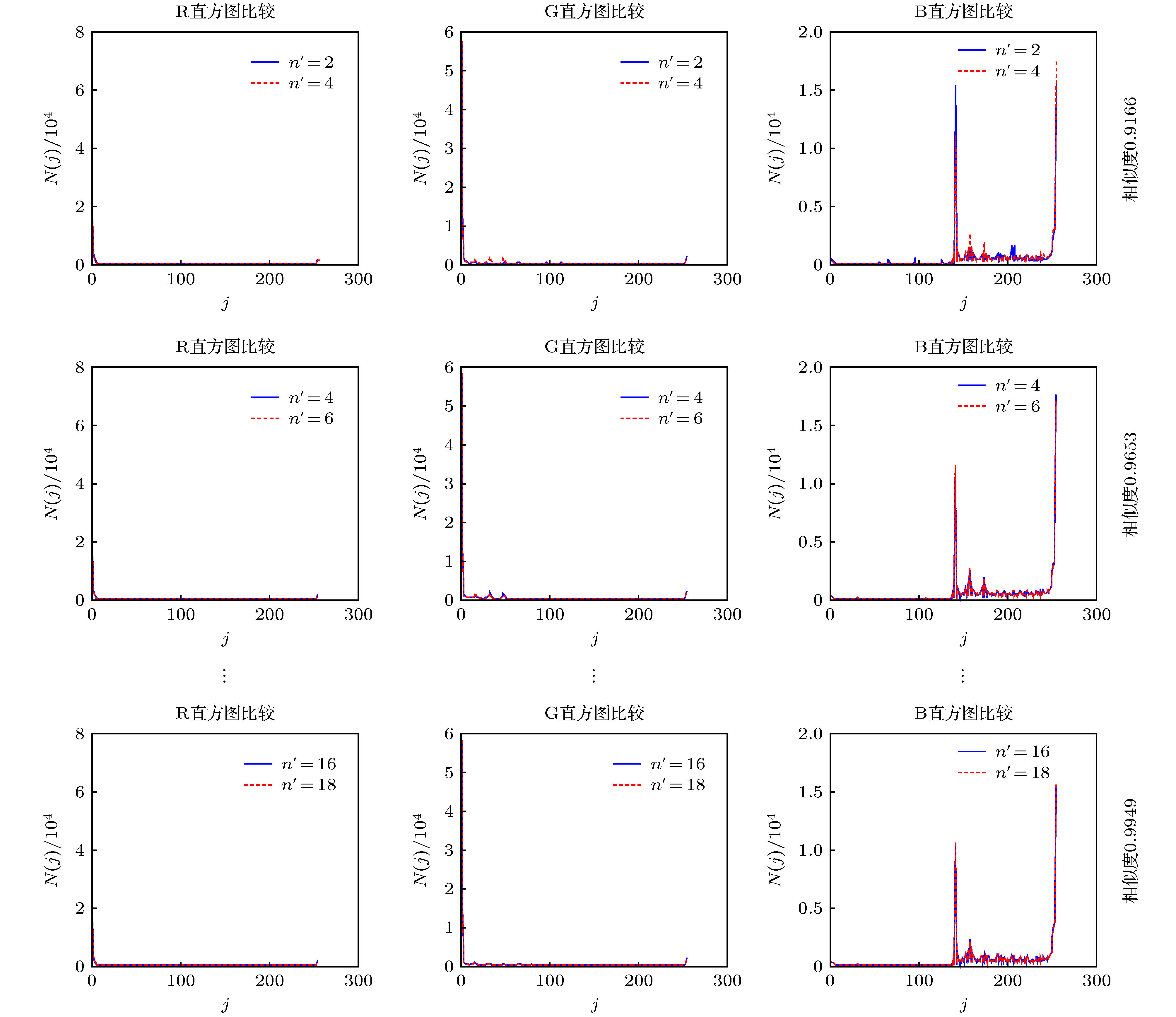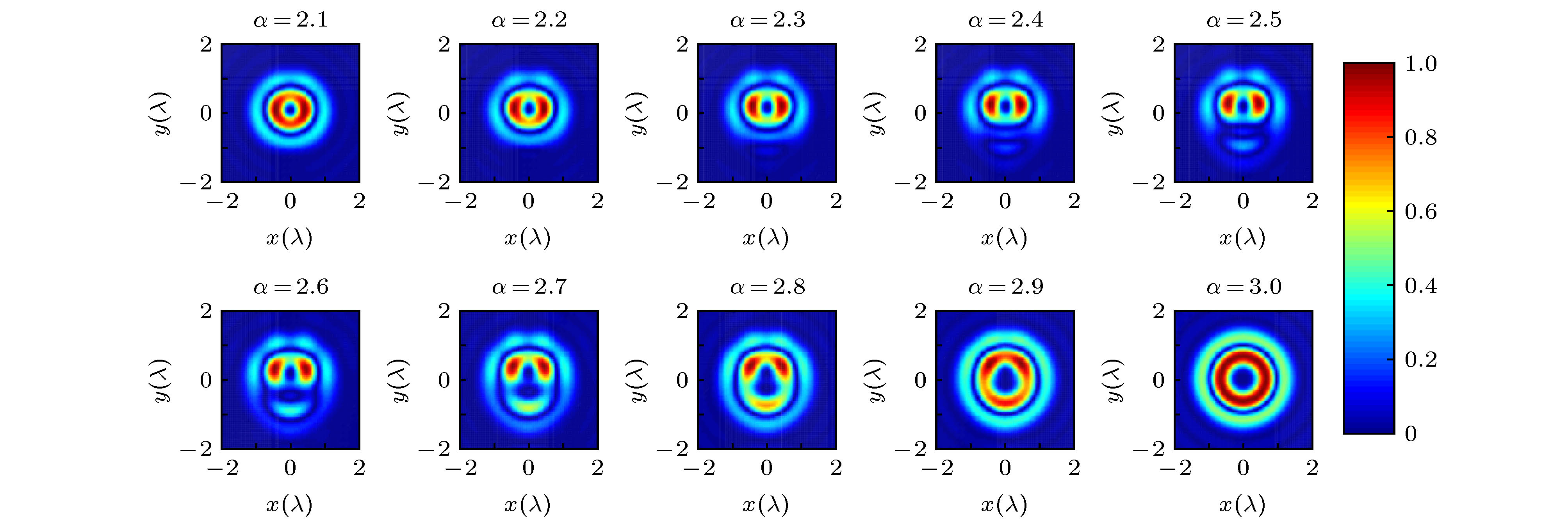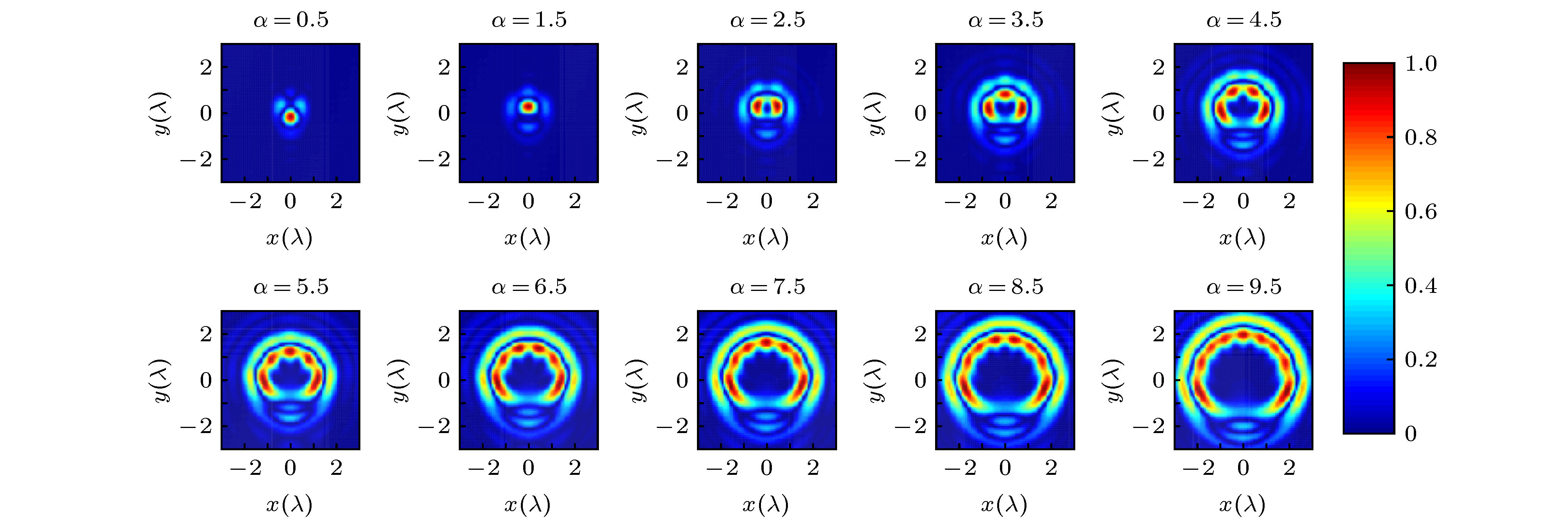-
All-optical magnetic recording based on the inverse Faraday effect has become a research hotspot in recent years due to its ultra-high storage density and ultra-fast magnetization reversal rate. Existing studies have shown that by optimizing the phase modulation or performing 4π tight focusing of azimuthally polarized vortex beams, high-resolution longitudinal magnetization fields with different axisymmetric intensity patterns can be generated. In order to meet the requirements of more complex all-optical magnetic recording and asymmetric magnetic particle capture and manipulation, it is particularly important to generate an asymmetric light-induced magnetization field with adjustable center position. Studies have shown that the fractional vortex phase could lead to the asymmetric focal field distribution generation under tight focusing conditions, which means that the tightly-focused azimuthally polarized light carrying the fractional vortex phase can produce a novel asymmetric light-induced magnetization field. As a new degree of freedom for the regulation of the magnetization field, the fractional topological charge will bring more new phenomena, new effects and new applications in the field of interaction between light and matter. In this work, for the first time to our knowledge, the magnetization induced by tightly focused azimuthally polarized fractional vortex beam is studied based on the Richard-Wolf vector diffraction theory and the inverse Faraday effect. The equivalent approximation of the magnetization induced by azimuthally polarized fractional vortex beam regarded as a weighted superposition of magnetization induced and crossly induced by a finite number of azimuthally polarized adjacent integer-order vortex beams, where the number of the equivalent terms is chosen by using the histogram intersection method of the intensity distribution image of the magnetization field. The magnetization field distribution under different values of α are also numerically simulated. Studies have shown that magnetization induced by the azimuthally polarized fractional vortex beam is asymmetrically distributed. When the fractional vortex topological charge α belongs to [0.5,1.5], as the vortex topological load increases, the splitting phenomenon of the transverse distribution of magnetization field appears with the magnetization spot position shift in the direction perpendicular to the optical axis. When α equals 0.5 or 1.5, the maximum offset of the center of the magnetization spot is 0.24λ. When the fractional vortex topological charge α belongs to [2,3], the transverse distribution of magnetization field splits two hot intensity spots with gradually growing outer ring diameter. When the fractional vortex topological charge α tends to be an integer 3, the transverse distribution of magnetization field also gets round and symmetrical. In particular, when the fractional vortex topological charge α is a half-integer, especially larger than 3. The number of hot spots (
$\alpha - 0.5 $ ) of the intensity of the magnetization field and the number of dark spots ($ \alpha - 1.5 $ ) surrounded by them all have a positive correlation with the number of vortex order. The research in this paper is expected to have new applications in the fields of all-optical magnetic recording and the capture and manipulation of magnetic particles.-
Keywords:
- asymmetric distribution /
- fractional vortex /
- inverse Faraday effect /
- tight focus
[1] Pitaevskii L P 1961 Sov. Phys. JETP 12 5
[2] Pershan P S 1963 Phys. Rev. 130 919
[3] Weller D, Moser A 1999 IEEE Trans. Magn. 35 4423
 Google Scholar
Google Scholar
[4] Wang S C, Li X P, Zhou J Y, Gu M 2015 Opt. Express 23 13530
 Google Scholar
Google Scholar
[5] Zhang Y, Okuno Y, Xu X 2009 J. Opt. Soc. Am. B 26 7
[6] Zhan Q W 2009 Adv. Opt. Photon. 1 1
 Google Scholar
Google Scholar
[7] Jiang Y S, Li X P, Gu M 2013 Opt. Lett. 38 2957
 Google Scholar
Google Scholar
[8] Gong L P, Wang L, Zhu Z Q, Wang X L, Zhao H, Gu B 2016 Appl. Opt. 55 5783
 Google Scholar
Google Scholar
[9] Nie Z Q, Ding W Q, Shi G, Li D Y, Zhang X R, Wang Y X, Song Y L 2015 Opt. Express 23 21296
 Google Scholar
Google Scholar
[10] Wang S C, Li X P, Zhou J Y, Gu M 2014 Opt. Lett. 39 5022
 Google Scholar
Google Scholar
[11] Coullet P, Gil L, Rocca F 1989 Opt. Commun. 73 403
 Google Scholar
Google Scholar
[12] Berry V M 2004 J. Opt. A-Pure Appl. Op. 6 259
 Google Scholar
Google Scholar
[13] Leach J, Yao E, Padgett J M 2004 New J. Phys. 6 71
 Google Scholar
Google Scholar
[14] Gbur G 2016 Optica 3 222
 Google Scholar
Google Scholar
[15] 李阳月, 陈子阳, 刘辉, 蒲继雄 2010 物理学报 59 1740
 Google Scholar
Google Scholar
Li Y Y, Chen Z Y, Liu H, Pu J X 2010 Acta Phys. Sin. 59 1740
 Google Scholar
Google Scholar
[16] 方桂娟, 孙顺红, 蒲继雄 2012 物理学报 61 064210
 Google Scholar
Google Scholar
Fang G J, Sun S H, Pu J X 2012 Acta Phys. Sin. 61 064210
 Google Scholar
Google Scholar
[17] Zhang N, Davis J A, Moreno I, Lin J, Moh K J, Cottrell D M, Yuan X C 2010 Appl. Opt. 49 2456
 Google Scholar
Google Scholar
[18] Zhu J, Zhang P, Fu D Z, Chen D X, Liu R F, Zhou Y N, Gao H, Li F L 2016 Photon. Res. 4 187
 Google Scholar
Google Scholar
[19] Wen J S, Wang L G, Yang X H, Zhang J X, Zhu S Y 2019 Opt. Express 27 5893
 Google Scholar
Google Scholar
[20] Liu C X, Chew K H, Wu Y, Chen R P 2020 J. Opt. Soc. Am. A 37 327
 Google Scholar
Google Scholar
[21] Tao S H, Yuan X C, Lin J, Peng X, Niu H B 2005 Opt. Express 13 7726
 Google Scholar
Google Scholar
[22] Guo C S, Yu Y N, Hong Z P 2010 Opt. Commun. 283 1889
 Google Scholar
Google Scholar
[23] Du F R, Zhou Z H, Tan Q F, Yang C X, Zhang X Q, Zhu L Q 2013 Chin. Phys. B. 22 064202
 Google Scholar
Google Scholar
[24] 李新忠, 台玉萍, 李贺贺, 王静鸽, 聂兆刚, 汤洁, 王辉, 尹传磊 2016 中国激光 43 0605002
 Google Scholar
Google Scholar
Li X Z, Tai Y P, Li H H, Wang J G, Nie Z G, Tang J, Wang H, Yin C L 2016 Chin. J. Las. 43 0605002
 Google Scholar
Google Scholar
[25] Xu H F, Zhang R, Sheng Z Q, Qu J 2019 Opt. Express 27 23959
 Google Scholar
Google Scholar
[26] Vetsch E, Reitz D, Sagué G, Schmidt R, Dawkins S T, Rauschenbeutel A 2010 Phys. Rev. Lett. 104 203603
 Google Scholar
Google Scholar
[27] Richards B, Wolf E 1959 Proc. Roy. Soc. A. 253 1274
[28] Youngworth K S, Brown T G 2000 Opt. Express 7 77
 Google Scholar
Google Scholar
[29] Hertel R 2006 J. Magn. Magn. Mater. 303 L1
[30] 米兰·桑卡, 瓦茨拉夫, 罗杰·博伊尔 著 (艾海舟, 武勃 译) 2003 图像处理、分析与机器视觉(北京: 清华大学出版社) 第21−127页
Sonka M, Hlavac V, Boyle R (translated by Ai H Z, Wu B) 2003 Image Processing, Analysis, And Machine Vision (Beijing: Tsinghua University Press) pp21−127 (in Chinese)
[31] 加里·布拉德斯基, 阿德里安·凯布勒 著 (于仕琪, 刘瑞祯 译 2009 学习Open CV[M]. (北京: 清华大学出版社) 第155−279页
Bradski G, Kaebler A (translated by Yu S Q, Liu R Z) 2009 Learn Open CV [M] (Beijing: Tsinghua University Press) pp155−279 (in Chinese)
-
-
[1] Pitaevskii L P 1961 Sov. Phys. JETP 12 5
[2] Pershan P S 1963 Phys. Rev. 130 919
[3] Weller D, Moser A 1999 IEEE Trans. Magn. 35 4423
 Google Scholar
Google Scholar
[4] Wang S C, Li X P, Zhou J Y, Gu M 2015 Opt. Express 23 13530
 Google Scholar
Google Scholar
[5] Zhang Y, Okuno Y, Xu X 2009 J. Opt. Soc. Am. B 26 7
[6] Zhan Q W 2009 Adv. Opt. Photon. 1 1
 Google Scholar
Google Scholar
[7] Jiang Y S, Li X P, Gu M 2013 Opt. Lett. 38 2957
 Google Scholar
Google Scholar
[8] Gong L P, Wang L, Zhu Z Q, Wang X L, Zhao H, Gu B 2016 Appl. Opt. 55 5783
 Google Scholar
Google Scholar
[9] Nie Z Q, Ding W Q, Shi G, Li D Y, Zhang X R, Wang Y X, Song Y L 2015 Opt. Express 23 21296
 Google Scholar
Google Scholar
[10] Wang S C, Li X P, Zhou J Y, Gu M 2014 Opt. Lett. 39 5022
 Google Scholar
Google Scholar
[11] Coullet P, Gil L, Rocca F 1989 Opt. Commun. 73 403
 Google Scholar
Google Scholar
[12] Berry V M 2004 J. Opt. A-Pure Appl. Op. 6 259
 Google Scholar
Google Scholar
[13] Leach J, Yao E, Padgett J M 2004 New J. Phys. 6 71
 Google Scholar
Google Scholar
[14] Gbur G 2016 Optica 3 222
 Google Scholar
Google Scholar
[15] 李阳月, 陈子阳, 刘辉, 蒲继雄 2010 物理学报 59 1740
 Google Scholar
Google Scholar
Li Y Y, Chen Z Y, Liu H, Pu J X 2010 Acta Phys. Sin. 59 1740
 Google Scholar
Google Scholar
[16] 方桂娟, 孙顺红, 蒲继雄 2012 物理学报 61 064210
 Google Scholar
Google Scholar
Fang G J, Sun S H, Pu J X 2012 Acta Phys. Sin. 61 064210
 Google Scholar
Google Scholar
[17] Zhang N, Davis J A, Moreno I, Lin J, Moh K J, Cottrell D M, Yuan X C 2010 Appl. Opt. 49 2456
 Google Scholar
Google Scholar
[18] Zhu J, Zhang P, Fu D Z, Chen D X, Liu R F, Zhou Y N, Gao H, Li F L 2016 Photon. Res. 4 187
 Google Scholar
Google Scholar
[19] Wen J S, Wang L G, Yang X H, Zhang J X, Zhu S Y 2019 Opt. Express 27 5893
 Google Scholar
Google Scholar
[20] Liu C X, Chew K H, Wu Y, Chen R P 2020 J. Opt. Soc. Am. A 37 327
 Google Scholar
Google Scholar
[21] Tao S H, Yuan X C, Lin J, Peng X, Niu H B 2005 Opt. Express 13 7726
 Google Scholar
Google Scholar
[22] Guo C S, Yu Y N, Hong Z P 2010 Opt. Commun. 283 1889
 Google Scholar
Google Scholar
[23] Du F R, Zhou Z H, Tan Q F, Yang C X, Zhang X Q, Zhu L Q 2013 Chin. Phys. B. 22 064202
 Google Scholar
Google Scholar
[24] 李新忠, 台玉萍, 李贺贺, 王静鸽, 聂兆刚, 汤洁, 王辉, 尹传磊 2016 中国激光 43 0605002
 Google Scholar
Google Scholar
Li X Z, Tai Y P, Li H H, Wang J G, Nie Z G, Tang J, Wang H, Yin C L 2016 Chin. J. Las. 43 0605002
 Google Scholar
Google Scholar
[25] Xu H F, Zhang R, Sheng Z Q, Qu J 2019 Opt. Express 27 23959
 Google Scholar
Google Scholar
[26] Vetsch E, Reitz D, Sagué G, Schmidt R, Dawkins S T, Rauschenbeutel A 2010 Phys. Rev. Lett. 104 203603
 Google Scholar
Google Scholar
[27] Richards B, Wolf E 1959 Proc. Roy. Soc. A. 253 1274
[28] Youngworth K S, Brown T G 2000 Opt. Express 7 77
 Google Scholar
Google Scholar
[29] Hertel R 2006 J. Magn. Magn. Mater. 303 L1
[30] 米兰·桑卡, 瓦茨拉夫, 罗杰·博伊尔 著 (艾海舟, 武勃 译) 2003 图像处理、分析与机器视觉(北京: 清华大学出版社) 第21−127页
Sonka M, Hlavac V, Boyle R (translated by Ai H Z, Wu B) 2003 Image Processing, Analysis, And Machine Vision (Beijing: Tsinghua University Press) pp21−127 (in Chinese)
[31] 加里·布拉德斯基, 阿德里安·凯布勒 著 (于仕琪, 刘瑞祯 译 2009 学习Open CV[M]. (北京: 清华大学出版社) 第155−279页
Bradski G, Kaebler A (translated by Yu S Q, Liu R Z) 2009 Learn Open CV [M] (Beijing: Tsinghua University Press) pp155−279 (in Chinese)
Catalog
Metrics
- Abstract views: 9869
- PDF Downloads: 170
- Cited By: 0



















 DownLoad:
DownLoad:













